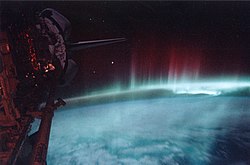Christianity
Apollo 8 Genesis Reading
On Christmas Eve, 1968 astronauts Bill Anders, Jim Lovell, and Frank Borman read from the Book of Genesis as Apollo 8 orbited the Moon. [3] A lawsuit by American Atheists founder Madalyn Murray O'Hair alleged that the observance amounted to a government endorsement of religion in violation of the First Amendment, [4] but the case was dismissed.


Protestantism
Apollo 11 astronaut Buzz Aldrin, a Presbyterian, performed a communion service for himself using a kit provided by his church. Aldrin had told flight director Chris Kraft of his plans and intended to broadcast the service back to Earth but opted not to at the request of Deke Slayton, due to the continuing controversy over Apollo 8's reading. [5]
A microfilm Bible brought to the surface of the Moon by Apollo 14 astronaut Ed Mitchell was auctioned off in 2011. [6] It was a King James Version created after three astronauts lost their lives in the Apollo 1 fire. [6] Ed White, one of the astronauts who perished, had wanted to take a Bible to the Moon. [6]
On the 2009 STS-128 flight to the International Space Station, astronaut Patrick Forrester brought a fragment of a Missionary Aviation Fellowship aircraft which had been used by the Operation Auca martyrs in Ecuador in 1956. [7]
Several members of the crew of the Space Shuttle Challenger tragedy mission STS-51-L were people of faith. Among them were Commander Dick Scobee and Pilot Michael J. Smith. Scobee was a Baptist who met his wife June at a church social event. After the tragedy, she would go on to write an article in Guidepost Magazine about how their faith helped her through the tragic time. Smith and his family attended a non-denominational Christian church in a community close to their home near Houston's NASA JSC Space Center.
Rick Husband, the Commander of the ill-fated STS-107 Columbia tragedy mission, was also a devout Christian. On the last-request forms that astronauts fill out before every flight, he left his pastor a personal note: "Tell them about Jesus; he's real to me." Later his wife Evelyn wrote a book about their life with him as an astronaut and the importance of their Christian faith entitled High Calling: The Courageous Life and Faith of Space Shuttle Columbia Commander Rick Husband. Likewise, his STS-107 crewmate Michael P. Anderson was also a devout Christian and when not on a mission for NASA, was an active member of the Grace Community Church choir.
Catholicism
A signed message from Pope Paul VI was included among statements from dozens of other world leaders left on the Moon on a silicon disk during the Apollo 11 mission. [8] Following the mission, William Donald Borders, Bishop of the Roman Catholic Diocese of Orlando, told the Pope that the 1917 Code of Canon Law placed the Moon within his diocese, as the first explorers had departed from Cape Kennedy which was under his jurisdiction. The claim was neither confirmed nor denied by the Pope, and the Moon is not recognized as part of the diocese in any official capacity. [9] [10] [11]
Following Buzz Aldrin's communion on the Moon, other astronauts have done the same in Earth orbit. Three Catholic astronauts on Space Shuttle mission STS-59 received Holy Communion on 17 April 1994. [12] NASA astronaut Michael S. Hopkins took a supply of six consecrated hosts to the International Space Station in September 2013, allowing him to receive the Eucharist weekly during his 24-week mission. [13]
In May 2011, Pope Benedict XVI of the Catholic Church talked to the crew of the Space Shuttle Endeavour while it was in Earth orbit. [14]
Russian Orthodox
In Russia, spaceflight crews are blessed by Russian Orthodox priests before launch, and their Soyuz rockets are also blessed on the launch pad. Cosmonaut Aleksandr Viktorenko initiated the crew blessing tradition when he requested one for the launch of Soyuz TM-20 in 1994. [15] [16]

Russian Orthodox Christmas was celebrated on the International Space Station, on January 7, 2011. [17] Cosmonauts had the day off, but one of the other crew posted on Twitter, "Merry Christmas to all Russia." [17] The whole crew also celebrated on December 25, two weeks prior. [17]
Cosmonauts sometimes at the request of Russian Orthodox church carry religious icons to space, which upon return to Earth are distributed to churches. [18]
